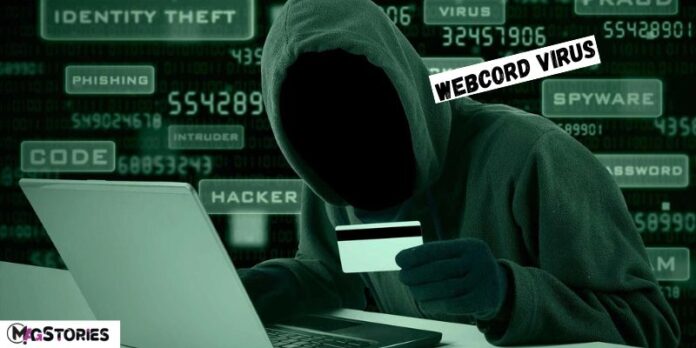To put it briefly, WebCord is one form of malware that is designed to attack computer systems. This virus was deliberately crafted to slip into your computer unnoticed and without your permission. When the virus enters the system, it can damage a lot of things. For example, it can steal confidential data, make your files inaccessible, or even completely freeze your system.
And finally, let’s find out what the WebCord virus is made of. See it as a miniature, the almost immutable creature that slips into your computer through the internet. It is called “WebCord” because a lot of times, it goes from one computer to another through web connections, like when you click on an unusual link or you download something strange.
The WebCord virus is tricky the way it is. It disguises itself as something innocent, like a cozy kitty video or a free app. However, when it gets into your computer it starts to make chaos all over. It could be possible that it will be copying your personal information, i. e. passwords or credit card numbers and sending them to the people who has developed the virus. It could damage so that you can’t find anything on your system. Moreover, the computer can even freeze or crash sometimes and stop working.
primary objectives
Infiltration
Initially, I will focus on infiltration. The WebCord computer virus is designed to creep into systems silently without being detected. It uses the phishing email, malicious downloads, and exploiting the vulnerabilities in software to get in. After it is inside, it becomes hard to find and take away.
data theft
The second issue is data theft when infected by the WebCord virus. It works by hacking into your system and looking for useful information, such as log in credentials, financial data, and personal information. After it has found its target, it will send the data in a silent manner to its creators and it endangers your privacy and safety.
Corruption
Another aim of the WebCord is that of corruption. As soon as the malware has made its way into your system, it can start altering and manipulating files, programs, and even operating system settings. This can result in files being unreachable, programs running weirdly, or even a whole system remaining unstable. The object of this behavior is to trigger chaos and confusion.
system malfunction
And finally, one of the goals of the WebCord virus is disrupting system functions. Through the manipulation of certain system components, it can result in abnormalities, crashes, or even full system failure. Not only will this hamper your workflow but may also cause some permanent damage to the computer. The ultimate aim is to make your system unusable or at least make it considerably reduced.
How Does WebCord Virus Work
Description of the Infection Process
gains entry
The WebCord Virus enters your computer to replicate its malicious code all over your system. It can start by concealing itself in system files or pretending to be a normal software to escape detection. This covert behavior greatly hampers antivirus programs’ capabilities to detect and remove the virus from the infected computer.
establishes a foothold within your system
In continuation of its plan of attack, the WebCord Virus first gains a foothold within your system, allowing it to execute its purpose. This could be done either by stealing sensitive information, like passwords or financial data, or by damaging the system’s functions. The virus behaves in such a way that it is virtually undetectable, becomes visible in its effects only after certain time.
continues to operate within your system
One of the main characteristic of WebCord Virus is that it is a self-replicating virus which means it can replicate itself in other files or in other devices connected to your network. This prompt transmission possesses the threat of the rapid escalation which can impact many computers, as well as the confidentiality of the data.
Methods of Propagation
Detail how the virus spreads from one system to another
Certainly!With regard to the WebCord virus and the threat it poses, it is imperative to look into how it is transmitted from one system to another. This contemptible program did not appear out of nowhere; it usually comes to computers through various routes. One of the most common methods is email attachments or links. They can disguise the malware as a harmless file or a link that looks like legit website, so users open them without thinking. As soon as you click on the WebCord virus, it can easily spread all over your system, infecting the files and increasing the risk to your system security.
Activities Engaged in by WebCord Virus

List the various actions the virus can perform after infecting a system
Once WebCord virus enters your computer through a back door, it can perform number of destructive actions. To start-off, it might be snooping into your private things. That way it could be intruding into your files, perusing for stuff like passwords, bank details, or some highly confidential info. Once it gets digitally hold of that information, it could create huge problems like misusing your accounts or even stealing your identity. Therefore, you should be alert to any indications of WebCord virus because it helps protect your data.
Signs and Symptoms of WebCord Infection
Slow Performance: One of the main signs of a WebCord virus infection can be found in a decrease in operating performance. Your system may be running slowly if the virus has been consuming RAM (resources) in the background.
Unexpected Pop-Ups or Ads: Another sign that your device has been infected with malware is the appearance of unexpected pop-ups or ads, especially the one’s look suspicious or irrelevant to the sites you visit. These pop-ups may consist of links to malicious sites or attempts to collect private information.
Unexplained Changes in Settings: If you observe modifications in your computer’s settings which were not made by you, such as changing of your home page and default search engine, it is possible that there is a WebCord virus infection. Frequently, viruses play with settings in order make browsers to open dangerous sites or harvest valuable information via the background.
Unusual Network Activity: Watch your network activity. Data transfer anomalies or network usage peaks, that you have not initiated, may be a sign that your computer is secretly transmitting data through the WebCord virus to remote servers.
Missing Files or Programs: One of the strategies that is adopted by WebCord virus is to delete or hide files and programs in the computer. If you try to locate the important files and programs suddenly vanish from there without your agreement, there is a high probability that your system has been hacked.
Security Warnings: Pay attention to the security warnings or alerts that your operating system or antivirus software could show. These warnings may suggest that a WebCord virus is detected or your computer becomes vulnerable to infection.
High CPU or Memory Usage: Monitor your computer’s CPU and memory utilization. If you spot very high usage at a time while you don’t use processor-hungry programs, it could be a signal of a WebCord virus hidden in memory.
Preventive Measures
up to date antivirus software
One of the primary ways to defend against the WebCord virus is updating your antivirus system to the latest software version. Antivirus programs search for and destroy known viruses including the WebCord virus that could harm your computer before you get infected. Regularly updating your antivirus software guarantees that it can detect and halt the newest threats including any newly hatched forms of WebCord virus.
caution when downloading files or clicking on links from unknown sources
The next important tactic is for you to practice caution while downloading files or clicking on links from unfamiliar sources. The WebCord virus usually spreads through the malicious email attachments, infected websites or misleading links. Consequently, source identification of those files or links you interact with is a must. Be vigilant of emails coming from unknown addresses especially if they have unexpected attachments or ask you to visit random sites. Your system can be made less prone to WebCord virus spread by being careful and avoiding all suspicious online activities.
cybersecurity hygiene
Also, adopting robust cybersecurity habits might keep WebCord infection away. This involves doing a backup frequently of your vital files and data to an external hard disk or cloud server. If your computer is infected with the WebCord virus or any other malicious software, the backups will provide you with the means of restoring your data without experiencing permanent loss. Moreover, having safe browsing habits, like staying away from unsecured websites and using secure passwords, enables you to defend yourself from the variety of online threats like the WebCord virus.
Removal of webcord virus
identifying the symptoms of the infection
First and foremost, the process of WebCord virus removal begins by identifying the symptoms of the infection. This might be slow loading, abnormal pop-up windows, browser setting changes or files modification that cannot be explained. If the WebCord virus has infected your system, it is of great importance to act promptly, as this will help to prevent further system damage.
reputable antivirus
The next move will be to run an appropriate antivirus or antimalware programme to perform a thorough scan of your system. Ensure your antivirus software is updated to detect and remove the WebCord virus and any related malware. Identify and quarantine or delete any identified threats so they cannot cause further harm.
manually removing
Besides the antivirus software utilization, you can also manually remove the WebCord virus components by accessing your computer’s control panel and uninstalling any suspicious programs or browser extensions. Be mindful when deleting files because deleting crucial system files can lead to unintended consequences.
Update your operating system
Now, after you get rid of the WebCord virus, you need to amplify security of your computer to avoid future infection. Make sure you keep your operating system, web browsers, and other software up to date to avoid malware weaknesses that WebCord virus exploits. You can install a well-known ad blocker and be careful when downloading files or clicking on buttons that lead to unknown websites.
Conclusion:
In summary, one should remember the seriousness of the WebCord Virus danger. WebCord Virus is a bad news for computer systems as it poses the risk of disclosing sensitive information, changing the data, and causing system breakdowns. The knowledge of this type of malware is essential part of the security against it. Through diligence and using reliable antivirus software and frequent upgrading of the network defenses, people and organizations can reduce their chances to be infected by the WebCord Virus. Keep in mind that prevention is much better than cure when it comes to malware threats. Keep in the know, keep safe, and keep lead of the WebCord Virus.
FAQ’s
1. What is the WebCord Virus?
The WebCord Virus is a type of malware specifically designed to infiltrate computer systems. It operates similarly to other viruses, with the primary goal of compromising system security, stealing data, or causing system malfunctions.
2. How does the WebCord Virus spread?
The WebCord Virus typically spreads through malicious websites, phishing emails, or compromised software downloads. It may also exploit vulnerabilities in outdated software or operating systems to gain access to a computer system.
3. What are the signs of a WebCord Virus infection?
Common signs of a WebCord Virus infection include sudden slowdowns in system performance, unusual pop-up windows or advertisements, unexplained changes to system settings, and the appearance of unfamiliar files or programs on the computer.
4. What are the risks associated with the WebCord Virus?
The risks associated with the WebCord Virus include the theft of sensitive information such as login credentials, financial data, or personal information. Additionally, the virus may corrupt or delete important files, leading to data loss or system instability.
5. How can I protect my computer from the WebCord Virus?
To protect your computer from the WebCord Virus, it is essential to install reputable antivirus software and keep it updated regularly. Avoid clicking on suspicious links or downloading files from unknown sources, and be cautious when opening email attachments or visiting unfamiliar websites.
6. Can the WebCord Virus be removed?
Yes, the WebCord Virus can be removed using antivirus software specifically designed to detect and eliminate malware threats. It is important to act promptly upon detecting an infection to minimize potential damage to your computer system and data.





